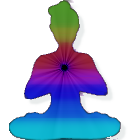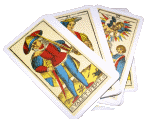
Haindl Tarot
FATHER OF WANDS - BRAHMA
The Father of Wands is Brahma, the Creator in the Trimurti of Creator, Preserver, Destroyer. Despite the Tantra claims for Kali as the origin of all three, most Hindus see these as Brahma, Vishnu, and Shiva. Western people tend to look upon this group as similar to the Christian trinity. However, while the Christian idea originates in a single Godhead, the three Hindu Gods are more loosely bound together. Hindu theology teaches that all Gods manifest out of a single source. Historically, however, distinct sects (or religions) worshipped each of the Gods. We could say perhaps that while Christianity began as a single religion and later split into various Churches, Hinduism actually began as several religions that later became unified. Some rivalry remains, with some areas of India following one God (most commonly Vishnu or Shiva) more than the others. Just as Tantra claims that its primary deity, Kali, originated the others, so various stories describe Brahma, or Vishnu, or Shiva, as the source of all the Gods.
Brahma was originally the God of the priestly caste, the most intellectual and also the most patriarchal. He has never drawn the common people like the warmer Vishnu, or the wild Shiva. In the old myths, the God Prajapati created the universe and the other Gods. The Larousse Encyclopedia of Myth describes Brahma as an abstraction of Prajapati, more of an idea. (We should not carry this too far. Brahma appears as an active character in many myths, much less of an idea than the Father in Catholic doctrine.)
The name possibly comes from Brahman, the holy power that gives life to the cosmos and everything in it (we should not confuse this term with brahmin, the name of Brahma's priests). As Creator, Brahma would be the first manifestation of this power. Compared with the God of Genesis, YHVH, the unknowable source, Brahma is the form the unknowable takes. Creation in Genesis happens once and for all time. In Hindu myth, the universe lasts for a vast length of time, preserved by Vishnu at dangerous moments, until Shiva (or Kali) dissolves it in the dance. Then, after the long night, when only Brahma exists, creation once more emerges and the cycle begins again. As we saw in the introduction to Wands, Brahma, too, will finally vanish.
We see in the Father of Wands a traditional representation of Brahma. The footprint above his head comes from authentic symbology. Here, it links the Father of the East to Bigfoot, the Father of the West. Hermann Haindl has painted the picture in soft colors, giving us a sense of calm, of Brahma as balanced and unmoving. Like Kali, Brahma has four arms. The image suggests power beyond human limitations (how many times do people say, "I wish I had four hands"?). The number four also refers to universal law. We also see four faces. They symbolize the four elements, the four directions (important in India as in America), and the four yugas, the great ages in each cycle of creation. The four faces blend into each other. This reminds us that separateness is an illusion, a fascinating spectacle. Because the faces blend, they contain only five eyes. We also see five lines on Brahma's arms. In the Tarot this recalls trump 5, the Hierophant, symbol of priestly wisdom.
Brahma wears a cord across his chest, a token of the priestly caste, or Brahmins. The white cloth signifies this as well, plus the fringed cape. Under the caste system, each group wears different clothes, eats different foods, follows different restrictions, and so on.
The four hands show different aspects of the God. The upper-left makes a gesture, part of the complicated system of postures and body language that serves as prayer. The upper-right arm (the side of consciousness) holds a scroll containing religious laws (perhaps of the caste system, which so clearly favors the Brahmins). The lower-right hand holds a gold vessel containing milk. The lower-left hand holds a spoon for stirring the milk in the holy fire. Milk is a sacred food in India, for cows embody the Goddess. We see the same worship of the cow in Egypt and Scandinavia. In Norse myth the cow is the oldest creation. While in India, Erica Haindl attended a ceremony in which the priest offered milk and other foods as a sacrifice.
Brahma wears a decorated crown, signifying religion as a developed concept. In its various forms Hinduism stretches back thousands of years. Brahma takes the energy of Kali and calms it. As Creator, he channels it into existing forms. Kali is the night, Brahma the dawn.
DIVINATORY MEANINGS
In readings, Brahma signifies a man (or woman) who is calm, in command of the situation. He may tend toward passivity, or perhaps stuffiness. He follows traditional ways and expects others to do the same. At the same time, he is without anger or aggressiveness. He possesses a rooted quality that gives strength to others.
REVERSED
The negative side of the Father may come out in snobbishness, especially intellectual condescension to those less educated. He may believe too much in the official ideas of his society, dismissing as nonsense unorthodox concepts. On the other hand his attachment to tradition gives him a base from which to be kind to others. He does not just use tradition but believes in it. He is devout, not a hypocrite. As a father he loves his children, though they may feel a need to rebel against him.
Reversed, the Father of Wands becomes more down to Earth. He experiences doubts, weakness, confusion. If he comes through this experience he will emerge more tolerant of others, especially those who do not fit in with traditional patterns.










